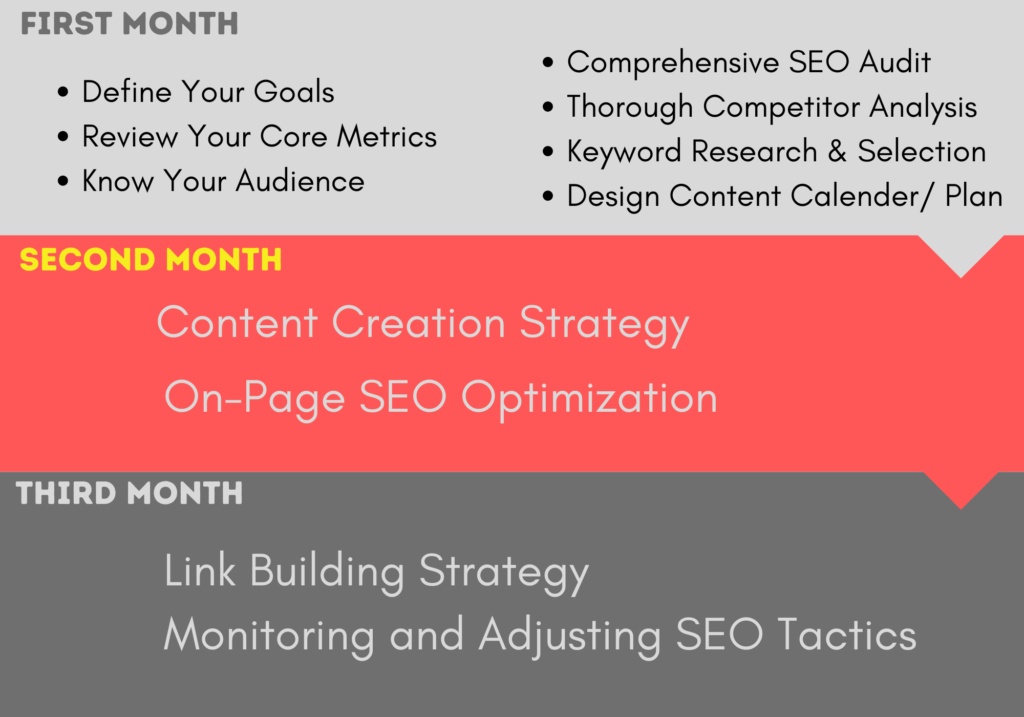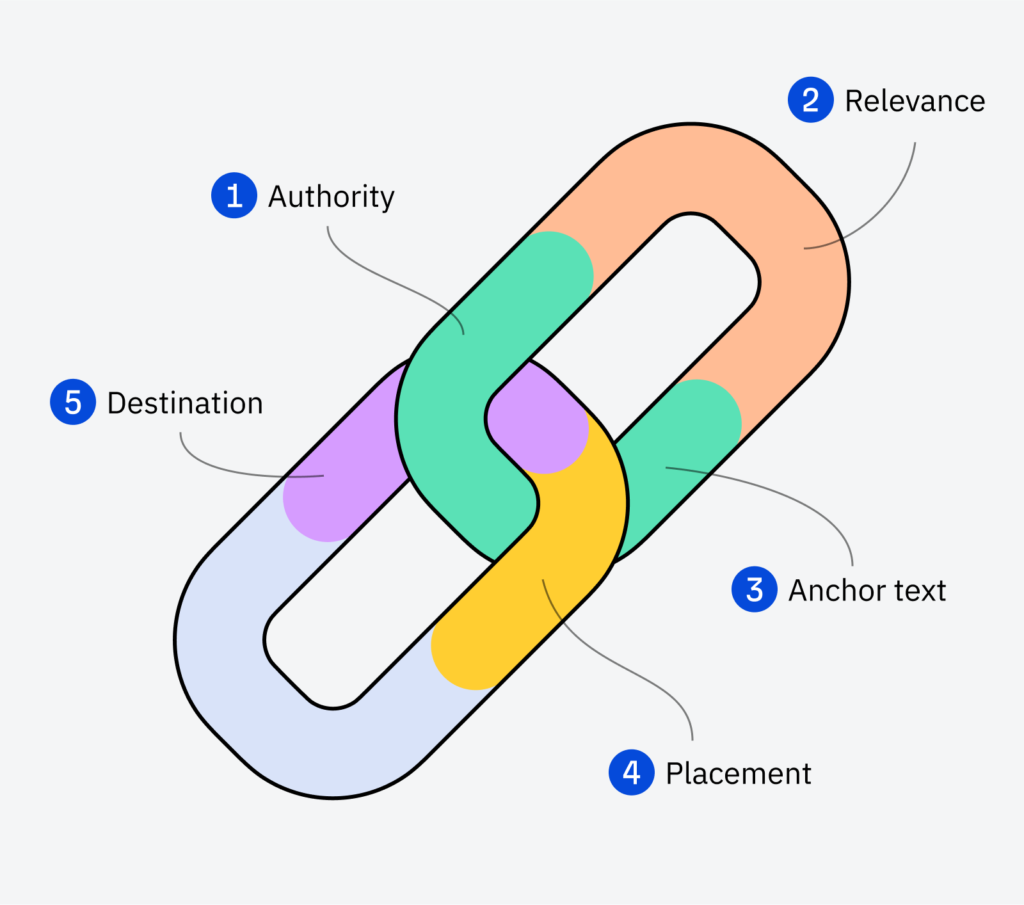Best Strategic 3 Months SEO Plan to Achieve Sustainable Growth

Implementing SEO strategies without a plan is a waste of both your investment and time.
If a businessman is new in the digital world of search, he/she might think that SEO is a one-time thing. This is not True, SEO is a long-term process.
The reason is that there is always ongoing competition in search engines So You always need ongoing optimization in order to take an edge over your competitors.
Without a master plan, a new website might not be able to compete, or it may take even more than 1 year to start getting some rankings.
A strategic plan will ensure that all your efforts are focused and concentrated in the right direction instead of being scattered.
After reading this article, Your mind will be clear about what steps should be taken at what time and a clear SEO roadmap for ranking your new website within 90 days. Let’s go.
Why 3 Months is a Sweet Spot for Results?
SEO comprises both long-term goals(such as link building) and short-term goals(like minor site optimizations). A 3-month plan is optimal for covering both such types of goals.
From laying your foundation to building an empire, This 3 months period is best for getting your website content indexed, ranked, and recognized by Google.
You can address minor issues like broken links meanwhile while handling major projects. A well-implemented 90-day strategic SEO plan can lead to a progressive boost in website traffic and rankings in the minimum time.
Necessary Steps Before Implementing a 3 Months Plan
Before initiating the 3 Months SEO Plan, must analyze these points and take further decisions accordingly.
Define Your Goals
What is your broader business goal?
Driving more traffic to gain credibility? Or Increasing Brand awareness to boost conversions?
Your strategy should align with your goal.
Know Your Audience
Targeted traffic results in higher conversions. But you must know your audience in order to target them.
You must be aware of what they engage with, what is their intent, what they are searching for, and what are the pain points.
You can use tools like Google Analytics or make surveys/feedback to get a better idea of your audience.
Review Your Core Metrics
First, have a thorough idea of where you stand. Save the initial metrics of your website in a file. This will help you compare them to the SEO results So you can know where you’re lacking and where you’re doing well.
Once all these steps are completed, now let’s implement the plan.
First Month: Laying the Foundation of Your SEO Plan
Start with laying a high-strength foundation that can adeptly support the plans and efforts in the coming days.
Comprehensive SEO Audit
SEO audit is necessary to analyze what is needed and what is not for the best performance. It will help you remove useless content and structures from your website and identify the major problems.
There are following 5 main types of SEO Audits:
- Technical SEO audit
- Local SEO audit
- Content audit
- On-page audit
- Backlinks audit
SEO audit is not only meant to be done initially. Although it must be done side by side after a fixed time period(1 month is a sweet spot), especially after Google updates.
Thorough Competitor Analysis
Remember that, Your Competitor is Your Best Teacher.
Keep an eye on what your competitors are ranking for and from which content they are getting the traffic. Never copy their strategy, instead make your strategy after analyzing all your competitors.
Your focus must be on catching your competitors’ untapped topics and keywords. You can use tools like SEMrush or Ahrefs to make such an analysis. SEMrush is cheaper than Ahrefs but Ahrefs has much higher features. So it all depends on you, what you choose.
Here is what you should look for when analyzing your competitors:
- Strengths & Weaknesses
- Features or Products
- Traffic driving pages
- Ranking Keywords
- Target Audience
- Differentiators
- Backlinks
- Marketing
- Pricing
Keyword Research & Selection
Backbone of SEO is keyword research. You must find the untapped keywords. You can use both Free and Paid Tools for keyword research. Do check for these characteristics of keywords:
Keyword Intent: It shows that what is the user who is searching for this specific keyword. There are four types of search intent:
- Transactional Intent
- Informational Intent
- Navigational Intent
- Commercial Intent
Search Volume(SV): How many times the keyword is searched monthly either worldwide or in your targeted region.
For a new website, there should be no minimum threshold for that, the reason is that “something is better than nothing”. But yes, if you’ve a limited budget, you must opt for good search volume keywords.
Instead of focusing on the volume, you must focus on the value that the keyword is giving. Also if a keyword has negligible search volume at the moment this doesn’t indicate that it will stay inactive in the future. So it can show potential in the coming days. You just have to focus on value.
Just try to stay below 1000 initially as the higher the search volume, the higher will be the competition.
Keyword Difficulty(KD): How much difficult is it for that specific keyword? Start with keywords having very low KD ( less than 15%)
Free tools are Google Keyword Planner, Google Analytics, Google Trends, WordStream, and UbberSuggest.
But if you want high features, pro-level data, and bulk data in a few clicks, you can try paid tools like Ahrefs and SEMrush.
Watch this video to get a better idea regarding Keyword research.
Complete your first month by collecting data regarding your competitors, golden keywords, and a thorough SEO audit of your website. Make proper documentation in Google Docs and Sheets.
Pro Tip: Use the KGR technique to find golden keywords that can help you start ranking in the minimum time. Also, try to learn technical knowledge and do short courses regarding your website on your own.
Design Content Calender/ Plan
Build a 3-month calendar regarding how and what will you publish and in what way. Try to understand what your audience wants to read and try starting from a micro niche. Here is a complete guide regarding how to develop a content strategy.
Second Month: Optimization and Control Strategy
Foundation is made. Now it’s action time. Start by optimizing your pages.
Content Creation Strategy
Content is the King when it comes to SEO. Your content must focus on providing value instead of covering too many keywords. Always prioritize quality over quantity.
Start posting content regularly. Content must be giving value to your targeted customers. Add the unique information in such a way that your reader gets all his required information.
Must include infographics, source links, and relevant PDFs/templates/videos to stand out from the rest. Never forget internal and external linking. Start by targeting a minor niche and build topical authority in that. You must be the best knowledge source in your industry/ niche.
Keep publishing content constantly and regularly as irregular posting will signal to Google that you’re not that serious/determined.
User experience is the most effective ranking factor of Google so you must give a good experience to the reader. Content must be clear, easy to understand, and without any fluff. Here is a list of Google Ranking Factors.
Pro Tip: Lengthy paragraphs also divert the reader’s attention therefore always keep your paragraphs less than 4 lines (less than 3 lines is a sweet spot).
On-Page SEO Optimization
Along with publishing, your content and your website must be optimized.
On-page SEO involves optimizing your site’s elements like title tags, meta descriptions, and headers. Ensure the natural placement of keywords within your content. Focus on your UI & UX. Check if the website isn’t taking too much time to load and also ensure that it is easy to navigate.
Watch this video to get a better idea of On-page SEO.
Third Month: Building Authority and Backlinks
By the third month, you’ll start gaining results from your efforts but to multiply and maintain those results, you’ve to build quality and relevant backlinks directing toward your website and it’s potential pages.
Link Building Strategy
You’ve to wisely choose the suitable websites to get backlinks from. Just remember a simple rule, the more difficult is to get a backlink, the more valuable is that backlink.
Must check for these points when evaluating a website for link building:
- Website Authority: How much link juice it can deliver? It is measured in different units by different tools like DA(Domain Authority) by Moz. DR(Domain Rating) by Ahrefs, AS(Authority Score) by SEMrush. You can use this free tool to measure that.
- Relevance: Links from the same topics/ niche website carry more weight than general/ irrelevant websites. Always go for a follow link. Nofollow links(Links with Nofollow attribute) can’t deliver any link juice/ authority.
You can check the link attribute by right-clicking on the link and clicking on the inspect. If there is nothing like nofollow mentioned there, then link is dofollow.
- Anchor text: Anchor text and words surrounding the anchor text must be topic-relevant. It will help Google to better understand what the referring page is about. Here is a research on anchor texts that can help you understand better.
- Destination: There are generally three destinations to which you point your backlinks. Either your homepage, your linkable assets, or the actual pages you want to rank (also known as “Money pages”)
- Placement: Link can be placed at the footer, header, or page content. Most value is provided by the links placed editorially within the content. Links placed in highly visible positions on a page signal Google a vote of confidence.
Links at highly visible positions can also lead readers to notice them and click on them.
Monitoring, Evaluating, and Adjusting SEO Tactics
We already discussed that SEO is a dynamic process. So you’ve to monitor performance and take necessary action whenever needed. Do SEO Audits after fixed intervals to evaluate everything in a more better way.
Use tools like GSC and Google Analytics to analyze your performance. Traffic isn’t the only thing that you can count on as a result but you must also focus on improving conversion rate, reducing bounce rate, and reader engagement and retention.
In this third month, you’ve to keep creating the content and start building backlinks for previous articles or pages. Meanwhile focusing on further backlink strategies and content strategies based on the site’s performance and periodic audits.

Making Long Story Short
SEO is a marathon, not an easy race. Adopting a 3-month plan can be an excellent way of kick-starting your business journey, especially for new business owners.
Breaking the process into manageable steps leads to tangible as well as sustainable results without getting overwhelmed by the cyclone of digital management. Remember, SEO is an ongoing effort and not a static process.
Once the three months are up, continue refining and adjusting your strategy based on what you’ve learned and what were the results.

